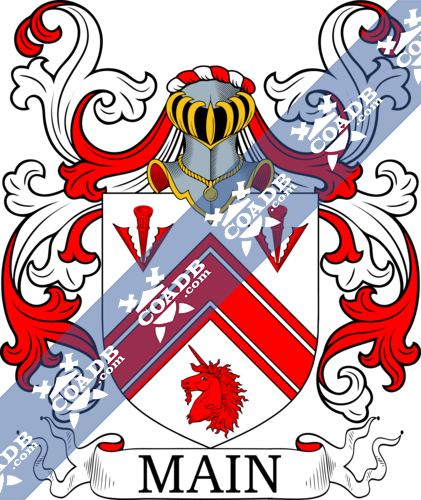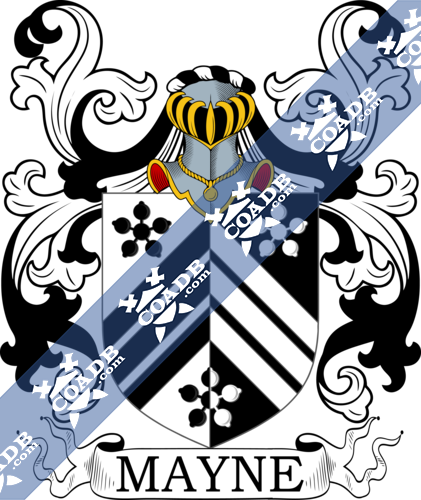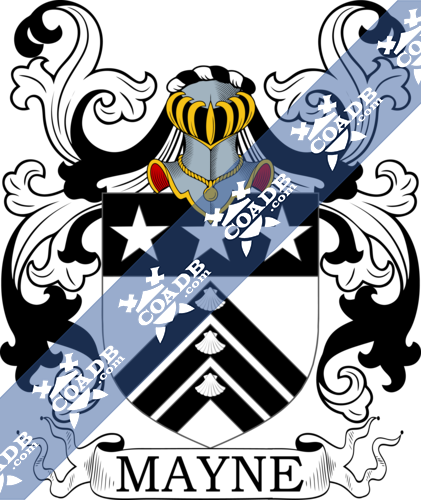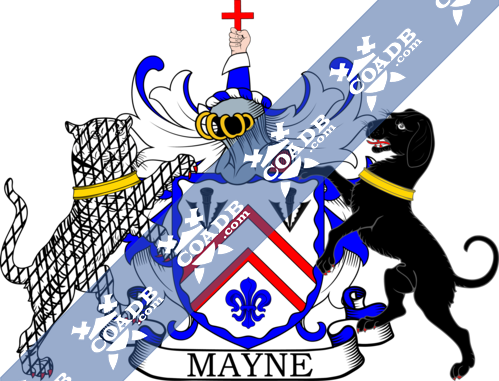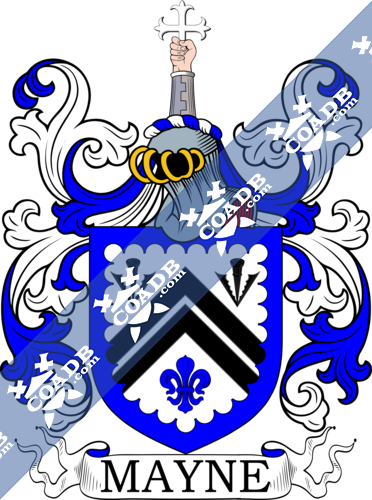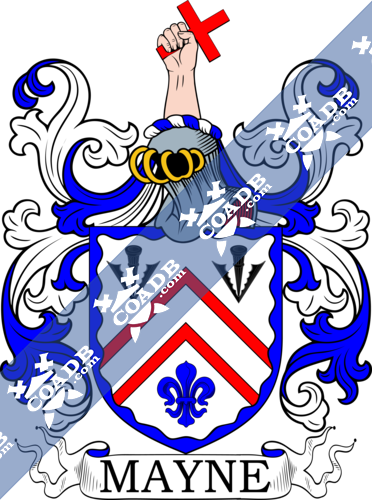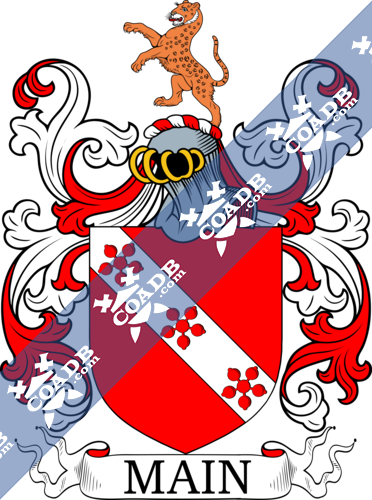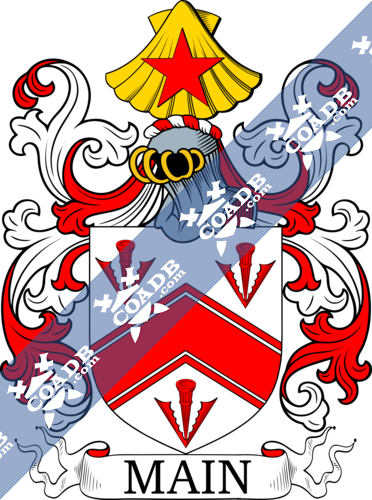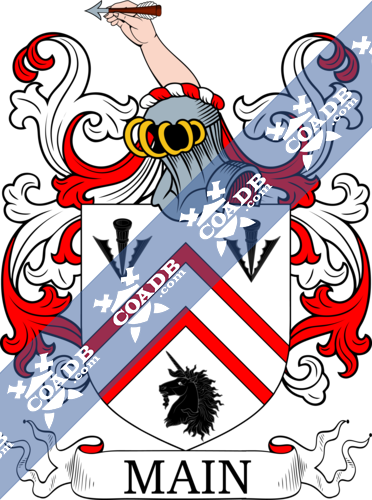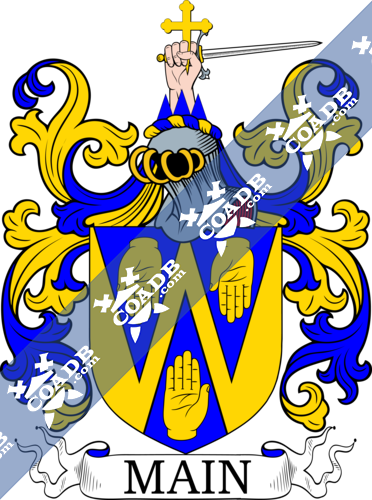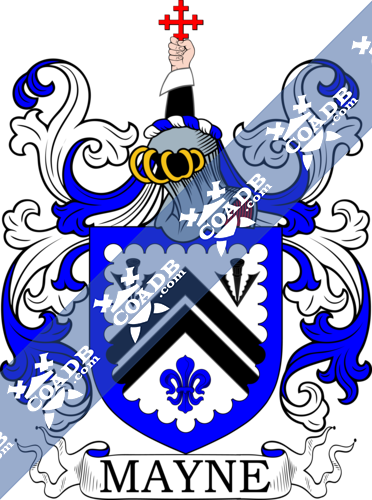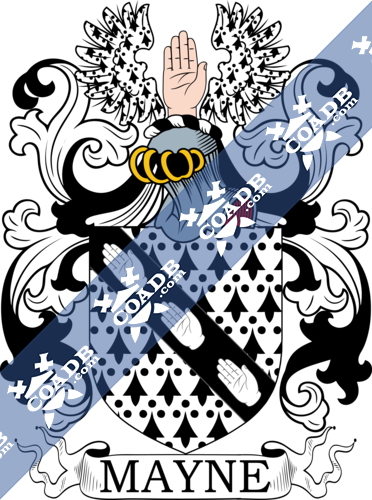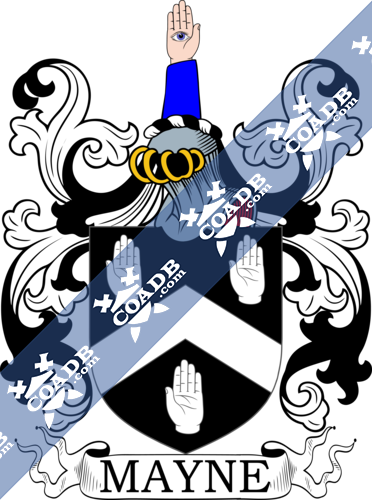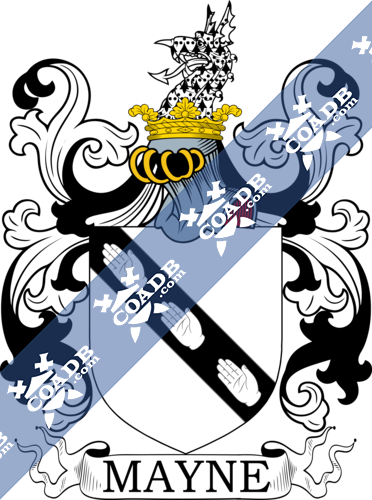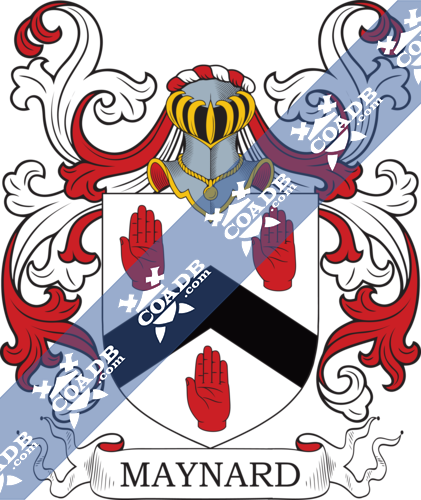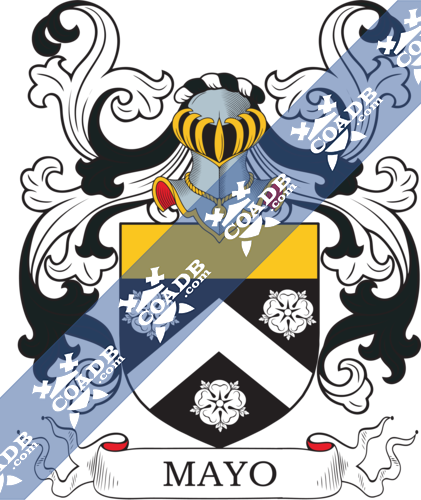Mayne Family Crest, Coat of Arms and Name History

Mayne Coat of Arms Gallery
Don’t know which Coat of Arms is yours?
We can do a genealogical research. Find out the exact history of your family!
Learn MoreMayne Origin:
England
Origin of Mayne:
It is fascinating and readable surname with different spelling forms like Mayne(s), Main(s), Maine, Meyne, and Menne and has many possible origins. This surname comes from the Menzies tribe in Scotland as Meinn is the provincial Gaelic form of Menzies, itself authentically being de Meyners, expressing a Norman geographical name, or possibly individual associated with the French division of Meine, residents of Normandy. It can also have been an expressive nickname which related to the Old French word” maine” which means stability or greatness, so the whole meaning of the name is the forceful person, or from the Ancient French word “main” which means fist or hand. So, the individual “with the hands” showing an individual who had skilled hands. One Mary Mayne named in August 1570, at St. Andrew’s, Holborn, London, and Augustyn Mayne called in October 1580, at St. Michael, Bassishaw, London. A fascinating name holder was John Mayne (1759 -1836), a Scottish poet, printer and finally a landowner and cooperative editor of the “Star.” For magazines, he wrote many poems and praised by Scott and Burns.
Variations:
More common variations of this surname are: Mayney, Mayane, Mayene, Mayone, Mayune, Maynne, Maynue, Maynne, Maynue, Mhayne, Mane, Mayn.
England:
The surname Mayne first originated in Devon at King’s Nympton, a church, in the union of South Molton, hundreds of Witheridge. The palace, which was the portion of the old estate of the crown, gained by King John to Joel de Mayne, by whose revolution it was repeatedly unconditional in the crown, and it by Henry III to Roger le Zouch.
The very first recording spelling of the family was shown to be that of Robert Main, which was dated 1204, an assistance in the “Assize Rolls of Yorkshire.” It was during the time of King John, who was known to be the “Lackland,” dated 1199 – 1216.
United States of America:
Individuals with the surname Mayne settled in the United States in two different centuries respectively in the 17th and 19th. Some of the people with the name Mayne who settled in the United States in the 17th century included Susanna Mayne, who arrived in Virginia in 1650. John Mayne landed in Virginia in 1655. Henry Mayne, who came to Virginia in 1661. Nathaniell Mayne at the age of 21, landed in Barbados in 1684.
Some of the people with the name Mayne who settled in the United States in the 19th century included Mary Mayne at the age of 21, arrived in Connecticut in 1812. Richard John Mayne, at the age of 41, landed in New York in 1831. William Mayne, who arrived in Allegany (Allegheny) Division, Pennsylvania in 1850. Thomas H Mayne at the age of 30, landed in Texas in 1858. Randall Mayne, who arrived in Virginia in 1884.
Australia:
Some of the people with the name Mayne who settled in Australia in the 19th century included Richard Mayne at the age of 25 arrived in South Australia in 1853 aboard the ship “Ramillies.” Elisha Mayne at the age of 19, a miner, arrived in South Australia in 1854 aboard the ship “Sultana.” James Mayne at the age of 18 arrived in South Australia in 1855 aboard the ship “Lady Macdonald.” Thomas Mayne at the age of 32 arrived in South Australia in 1855 aboard the ship “Taymouth Castle.” William Mayne at the age of 32 arrived in South Australia in 1856 aboard the ship “Aliquis.”
New Zealand:
Some of the people with the name Mayne who settled in New Zealand in the 19th century included Edward Mayne landed in Auckland, New Zealand in 1840. Joseph Mayne arrived in Auckland, New Zealand aboard the ship “Mermaid” in 1860. Robert Mayne arrived in Auckland, New Zealand aboard the ship “Inflexible” in 1870. James Mayne at the age of 22 arrived in Wellington, New Zealand aboard the ship “Glenlora” in 1873.
Here is the population distribution of the last name Mayne: United States 5,051; England 3,302; Ghana 879; France 392; Belgium 468; Jamaica 500; Australia 2,379; Northern Ireland 370; Canada 1,082; South Africa 1,479.
Notable People:
Andrew Mayne was an entertainer and producer.
Brent Mayne (born 1968), was an American Baseball referee.
Cuthbert Mayne (1544–1577), was an English Roman priest and saint.
Edgar Mayne (1882–1961), was an Australian cricket player.
Blazons & Genealogy Notes
1) (Farley Hill, co. Berks). Ar. two chevronels betw. as many pheons in chief sa. and a fleur-de-lis in base az. within a bordure engr. of the last. Crest—A cubit arm erect in armour, holding in the hand ppr. a cross flory ar.
2) Same Arms. Crest—A cubit arm erect ppr. habited sa. cuffed ar. holding a cross crosslet gu.
3) (Creslow, co. Bucks; granted June, 1604). Erm. on a bend sa. three dexter hands couped ar. Crest—A dexter hand ppr. betw. two wings erm.
4) (Teffont Ewyas, co. Wilts; descended from Joel de Maine, of Kings Nymet, temp. Henry I.). Motto, ancient—Await the day; modern—Virtuti fortuna comes. Ar. on a bend engr. sa. three dexter hands couped at the wrist of the first. Crest—Out of a mural coronet or, a dragon’s head erm.
5) (Littington, co. Devon, and London). Sa. a chev. betw. three sinister hands couped and erect ar. Crest—A cubit arm vested az. in the palm of the hand an eye all ppr.
6) (co. Essex). Per pale ar. and sa. three chevronels betw. as many cinquefoils counterchanged.
7) (Bornington, co. Hertford). Ar. on a bend sa. three sinister hands couped at the wrist of the first.
8) (co. Warwick, and Rowston, co. York). Ar. on a bend ea. three dexter hands couped of the field. Crest—Out of a ducal coronet or, a dragon’s head erm.
9) Ar. three chevronels sa. each charged with an escallop of the first, on a chief of the second three mullets of the field.
10) (Powis and Logie, co. Clackmannan; derived from the Mains, of Loehwood, co. Stirling). Motto—Virtuti fortuna comes. Ar. a chev. gu. voided of the field betw. two pheons in chief sa. and a fleur-de-lis in base az. a bordure wavy of the last. Crest—A dexter hand holding a plain cross gu.
11) (Baron Newhaven, extinct 1794; Sir William Mayne, descended from Mayne, of Logie, was so created 1770, d. s. p.). Motto—Virtuti fortuna comes. Ar. a chev. gu. voided of the field betw. two pheons in chief sa. and a fleur-de-lis in base az. a border wavy of the last. Crest—An arm erect couped below the elbow, habited az. cuffed ar. holding in the hand ppr. a cross in pale gu. Supporters—Dexter, a tiger ramp. guard. tenné armed gu. collared or; sinister, a talbot sa. armed and langued gu. collared or.
12) (co. Buckingham). Erm. on a bend sa. three dexter hands or.
13) (England). Gu. on a bend ar. three cinquefoils of the field. Crest—A leopard ramp. ppr.
14) (Scotland). Ar. a chev. cotised betw. three pheons gu. Crest—An escallop or, charged with a mullet gu.
15) (Easter House). Ar. a chev. cotised betw. two pheons in chief and a unicorn’s head erased in base of the last.
16) (Lochwood, co. Stirling). Motto—Projeci. Ar. a chev. gu. voided of the field betw. two pheons in chief and a unicorn’s head erased in base sa. Crest—A hand throwing a dart ppr.
17) (Edinburgh, 1685). Motto—Virtute et labore. Ar. on a chev. voided gu. betw. two fleurs-de-lis in chief and a unicorn’s head couped in base a pheon sa. Crest—A dexter hand holding an annulet or, stoned az.
18) (Rev. Thomas John Main, M.A.) Or three piles two issuant from the chief and one from the base az. each charged with a dexter hand couped at the wrist, those in chief pendent and that in base erect of the field. Crest—In front of a cubit arm erect ppr. holding a cross botonny fitchee in pale or and a sword fessewise the point to the dexter also ppr. pommel and hilt gold three piles reversed az.

